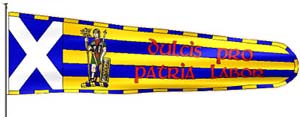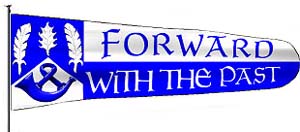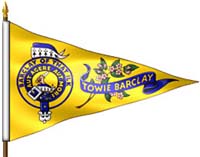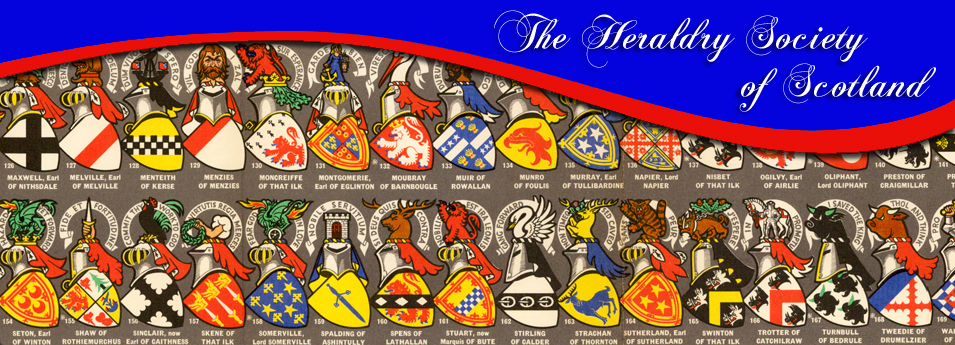|
|
| |
Scots Heraldry - The Heraldry
Society of Scotland |
. |
| |
Special Heraldic Flags
|
All the flags described so far may be used by any armiger.
However, there are flags which are authorised specially by the
Lord Lyon and are blazoned in the grant or matriculation of arms
of the armiger. These are the standard, guidon, pennon, and pinsel. |
|
|
|
The Standard |
|
|
|
The standard ia a
long, narrow, tapering flag, granted by the Lord Lyon only to
those who have a following, such as clan chiefs or chieftain. As a
'headquarters' flag, its principal use is to mark the gathering
point or headquarters of the clan, family or following and does
not necessarily denote the presence of the standard's owner as his
personal banner does. The standards of peers and barons have their
ends split and rounded; for others the end is unsplit and rounded.
At the hoist, the standard usually shows the owner's arms, though
some are still granted with the former practice of having the
national saltire in the hoist. The remainder of the flag is
horizontally divided into two tracts of the livery colours for
chiefs of clans or families, three tracts for very major branch
chieftains and four for others. Upon this background are usually
displayed the owner's crest and heraldic badges, separated by
transverse bands bearing the owner's motto or slogan. The whole
flag is fringed with alternating pieces of the livery colours. The
length of the standard varies according to the rank of its owner,
as follows: The Sovereign 8 yards, Dukes 7 yards, Marquesses 6.5
yards, Earls 6 yards, Viscounts 5.5 yards, Lords 5 yards, Baronets
4.5 yards and lastly Knights and Scottish barons 4 yards. (One
wonders if these ensigns are likely to come under European weights
and measures legislation soon!) |
|
|
 |
|
Standard of the Earl of Rothes
matriculated in 1977. |
|
|
The Guidon |
|
|
|
This is a long
flag similar in shape to the standard. The guidon is eight feet
long and is assigned by the Lord Lyon to non-baronial lairds who
have a following. It tapers to a round, unsplit end at the fly and
has a background of the livery colours of the owner's arms. The
owner's crest or badge is shown in the hoist and his motto or
slogan is lettered horizontally in the fly. |
|
|
 |
|
Guidon of Charles J. M.
Mckerrell of Hillhouse matriculated in 1985. |
|
|
The Pennon |
|
|
|
Strictly
speaking, a small guidon, four feet long, which nowadays is very
rarely assigned today. The pennon carries the owner's arms in the
hoist and his livery colours dividing the fly which tapers down to
a rounded end. This term pennon, however, is more commonly used to
refer to a long triangular flag borne at the end of a lance or
spear, or flown from the mast of a ship. |
|
|
|
 |
|
A Pennon designed for
Charles J. Burnett Esq. - Ross Herald, but not
matriculated. |
|
|
|
The Pinsel |
|
|
|
A small
triangular flag granted by the Lord Lyon only to chiefs or very
special chieftain barons for practical use to denote a person to
whom the chief has delegated authority to act in his absence on a
particular occasion. The flag is 4 feet 6 inches long by 2 feet
high, with a background of the main livery colour of the chiefs
arms. On it is depicted his crest within a strap and buckle
bearing the motto and outside the strap and buckle a circlet
inscribed with his title. On top of the circlet is set his coronet
of rank or baronial chapeau if any. In the fly is shown the plant
badge and a scroll with his slogan or motto. |
|
|
|
 |
|
The Pinsel of Peter Barclay
of Towie Barclay, Chief of the Clan Barclay - Matriculated
in 1999. (R. Squire) |
|
|
Manufacture |
|
|
|
No material is
wrong for a flag, although some are more suitable than others in
certain situations. For external use, including naval flags flown
at sea, the traditional woollen bunting has largely given way to
modem synthetic fibres such as polyesters. Indoors, and for
decorative purposes, silk, satin, damasks and brocade may be used,
as well as finer spun polyesters. In general, the brightest
possible colours give the best effect although luminescent dyes
are not recommended. Gold and silver are represented by yellow and
white respectively. However, special flags are sometimes decorated
with gold thread or paint, as for example, to emphasise a coronet.
Except in a few cases such as standards, fringes are regarded in
Scotland as mere decoration, to be added or not according to the
whim of the owner. If plain, they should be of the same metal as
chat which is predominant in the flag. They may also be made of
alternate pieces of the principal colour and metal of the flag.
Flags are a practical and prominent form of heraldic display and
however they are made, it is essential that they are suitable for
the purpose intended. In particular, flags to be flown on a flag
pole must be light enough to lift in the wind or the effect will
be lost. |
|
|
|
|
|
|
|
|
© The Heraldry Society of
Scotland last Update
27 Oct 2021 |
|
